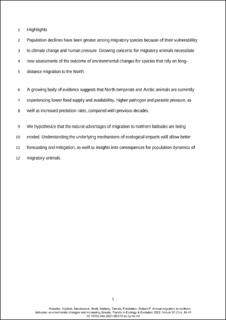| dc.contributor.author | Kubelka, Vojtěch | |
| dc.contributor.author | Sandercock, Brett | |
| dc.contributor.author | Székely, Tamás | |
| dc.contributor.author | Freckleton, Robert P. | |
| dc.coverage.spatial | Arctic | en_US |
| dc.date.accessioned | 2023-01-18T13:40:05Z | |
| dc.date.available | 2023-01-18T13:40:05Z | |
| dc.date.created | 2021-10-07T09:49:52Z | |
| dc.date.issued | 2022 | |
| dc.identifier.citation | Trends in Ecology & Evolution. 2022, 37 (1), 30-41. | en_US |
| dc.identifier.issn | 0169-5347 | |
| dc.identifier.uri | https://hdl.handle.net/11250/3044368 | |
| dc.description.abstract | Every year, many wild animals undertake long-distance migration to breed in the north, taking advantage of seasonally high pulses in food supply, fewer parasites, and lower predation pressure in comparison with equatorial latitudes. Growing evidence suggests that climate-change-induced phenological mismatches have reduced food availability. Furthermore, novel pathogens and parasites are spreading northwards, and nest or offspring predation has increased at many Arctic and northern temperate locations. Altered trophic interactions have decreased the reproductive success and survival of migratory animals. Reduced advantages for long-distance migration have potentially serious consequences for community structure and ecosystem function. Changes in the benefits of migration need to be integrated into projections of population and ecosystem dynamics and targeted by innovative conservation actions. | en_US |
| dc.description.abstract | Animal migration to northern latitudes: environmental changes and increasing threats | en_US |
| dc.language.iso | eng | en_US |
| dc.rights | Attribution-NonCommercial-NoDerivatives 4.0 Internasjonal | * |
| dc.rights.uri | http://creativecommons.org/licenses/by-nc-nd/4.0/deed.no | * |
| dc.title | Animal migration to northern latitudes: environmental changes and increasing threats | en_US |
| dc.title.alternative | Animal migration to northern latitudes: environmental changes and increasing threats | en_US |
| dc.type | Peer reviewed | en_US |
| dc.type | Journal article | en_US |
| dc.description.version | acceptedVersion | en_US |
| dc.rights.holder | © 2022 The Authors | en_US |
| dc.subject.nsi | VDP::Zoologiske og botaniske fag: 480 | en_US |
| dc.subject.nsi | VDP::Zoology and botany: 480 | en_US |
| dc.source.pagenumber | 30-41 | en_US |
| dc.source.volume | 37 | en_US |
| dc.source.journal | Trends in Ecology & Evolution | en_US |
| dc.source.issue | 1 | en_US |
| dc.identifier.doi | 10.1016/j.tree.2021.08.010 | |
| dc.identifier.cristin | 1944049 | |
| dc.relation.project | Egen institusjon: Norwegian institute for nature research (NINA) | en_US |
| cristin.ispublished | true | |
| cristin.fulltext | postprint | |
| cristin.qualitycode | 1 | |

